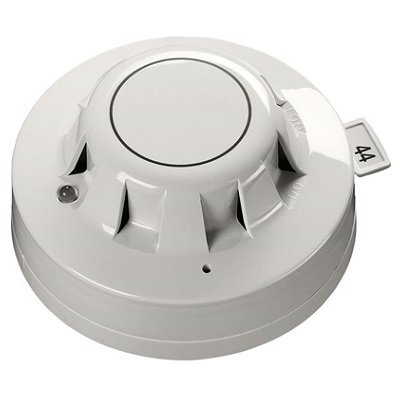Apollo Fire Detectors Ltd - Experts & Thought Leaders
Latest Apollo Fire Detectors Ltd news & announcements
Apollo Fire Detectors Ltd is pleased to announce the appointment of Nicola Tebble as the company’s new Marketing Director. Nicola joins Apollo with over 20 years of global experience in marketing and product management and has a proven track record of building and developing global teams responsible for delivering a strong product pipeline and compelling communications. New Marketing Director Appointed Nicola Tebble joins from Vaarst, a robotic and AI technology company Nicola Tebble joins from Vaarst, a robotic and AI technology company, where she held the position of Director of Product and Marketing. Prior to Vaarst, she spent 14 years across multiple product categories at Dyson, growing from an Account Director to the Global Head of Category within the B2B space. New product opportunities Rob Barcik, Apollo’s Managing Director, said: “I am very excited to have Nicola join Apollo and she will improve our ability to communicate with our customers and partners. Her strength in utilizing market insights to differentiate product roadmaps will build on our strong technical and NPD processes. This will allow us to identify new product opportunities and bring exciting solutions to the market.” Apollo’s Board of Directors are confident that Nicola’s approach to the role will further elevate the company’s position within the fire industry. Please join them in welcoming Nicola to her new role as Marketing Director.
Located in East London's healthcare hub, Newham University Hospital currently boasts a top-tier network of Advanced MxPro 5 panels, ensuring fire safety and peace of mind for patients, staff, and visitors. fire alarm network overhaul Newham University Hospital serves as a vital healthcare facility offering A&E, maternity, and specialist services. The building required a significant overhaul of its fire alarm network without interfering with the hospital’s round-the-clock operations. The process involved replacing the existing network with Advanced MxPro 5 panels. upgrade with panel installation The upgrade also needed to take into account future enhancements planned over the next three years Comprehensive rewiring was undertaken by the installation team at M&G Fire Protection, and additional panels were installed to meet the stringent requirements of the fire officers. This upgrade also needed to take into account future enhancements planned over the next three years, so required meticulous planning and execution. A total of 97 nodes were installed, covering more than 10,000 devices including 11 eight-loop panels, 10 four-loop panels, 8 two-loop panels, 44 one-loop panels, and 13 fault-tolerant remote display terminals. multi-protocol switch-over capabilities The fire system needed to be integrated with a wide range of building management systems, requiring complex cause-and-effect planning and programming to comply with HTM0503 standards governing fire safety in the design of healthcare premises. M&G Fire Protection leveraged Advanced's cutting-edge solutions, citing its versatile multi-protocol switch-over capabilities and intuitive cause-and-effect configuration. With a proven track record in deploying Advanced systems, M&G's choice was clear for this intricate upgrade. phased approach M&G minimized downtime and maintained system functionality throughout the upgrade Despite numerous hurdles, by adopting a phased approach and working in collaboration with hospital staff, M&G minimized downtime and maintained system functionality throughout the upgrade. Due to the success of this project, M&G was recognized with the 'Installation Company of the Year' award at this year's FSM Awards. cause-and-effect configuration Steve Middleton, Director, of M&G Fire Protection, stated, “We opted for Advanced panels due to their flexible cause-and-effect configuration, which makes setup, testing, and maintenance a breeze." He adds, "The intuitive display makes the panels very easy to use, and the integration with external services via the BMS card is straightforward and highly beneficial. Additionally, the network setup options and speed are impressive, reinforcing our confidence in Advanced's solutions.” flexible and versatile solutions Salvy Vittozzi, Advanced’s Regional Sales Manager for the South East, said "Advanced's fire safety solutions were ideal for Newham University Hospital due to their robust capabilities and ease of integration." He adds, "The flexibility and reliability of our systems ensured that, even with the complex requirements and round-the-clock operations of a major healthcare facility, we could deliver a seamless and effective fire safety solution." excellence and collaboration Salvy Vittozzi continues, "This project highlights our commitment to providing advanced technology that meets the highest standards and adapts to the evolving needs of critical environments like hospitals.” Completed on schedule and with ample room for future expansion, the project underscores both Advanced's commitment to delivering cutting-edge fire safety solutions and M&G's dedication to excellence and collaboration. MxPro 5 MxPro 5 can be used in single-loop, single-panel format, or easily configured into high-speed networks MxPro 5 is the fire industry’s pioneering multiprotocol fire panel and is certified by FM Approvals to EN 54 Parts 2 and 4. It offers customers a choice of four detector protocols and a completely open installer network, backed up by free training and support. MxPro 5 can be used in single-loop, single-panel format, or easily configured into high-speed networks of up to 200 panels covering huge areas. Ease of installation and configuration, as well as its wide range of peripheral options, make MxPro 5 customizable to almost any application. false alarm management capabilities The MxPro 5’s stand-out false alarm management capabilities are available as standard. AlarmCalm delivers unprecedented control of verification and investigation delays. By dividing sites up into virtual false alarm ‘building areas’ independent of fire zones, much more precise control of false alarm management and reduction strategies can be achieved that exactly fit the needs of each part of a building. An optional AlarmCalm button allows trained occupants to verify if they believe a local fire signal is a false alarm too – a highly effective way of eliminating unwanted alarms. BMS/graphics interface Multiple interfaces can be connected to the network catering to sites requiring control from several graphical PCs The MxPro 5 BMS/graphics interface allows BMS systems and graphical control PCs to be easily integrated with the MxPro 5 series of fire control panels and remote terminals using a simple RS232 connection. Multiple interfaces can be connected to the network catering to sites requiring control from several graphical PCs. As a world pioneer in the development and manufacture of intelligent fire systems, Advanced products are specified in locations around the world, from single-panel installations to large, multi-site networks. Advanced portfolio The Advanced portfolio includes complete fire detection systems, multiprotocol fire panels, extinguishing control, false alarm management, and reduction systems, as well as emergency lighting. Advanced is owned by FTSE 100 company Halma PLC – a global group of life-saving technology companies with a clear purpose to grow a safer, cleaner, healthier future for everyone, every day.
In the realm of fire detection and alarm systems, the visible costs associated with their purchase often represent merely the tip of the iceberg. The true cost of ownership encompasses a spectrum of factors that extend far beyond the initial installation price. Apollo Fire Detectors Ltd. recognizes the importance of considering the entire lifecycle performance of a system, from acquisition to ongoing operational expenses, to make informed decisions that optimize efficiency and effectiveness. CapEx versus OpEx Capital Expenditure (CapEx) versus Operational Expenditure (OpEx) serve as fundamental distinctions when evaluating the financial implications of fire detection systems. While CapEx pertains to the initial investment in fixed assets, OpEx encompasses the ongoing day-to-day expenses incurred in system maintenance and operation. Understanding these distinctions is crucial for assessing the total cost of ownership accurately. Pros and cons of Wired & Wireless fire system Apollo offers a range of fire detection systems, including both wired and wireless options, each with its own set of advantages and considerations. While wired systems may offer reliability and robustness, wireless systems provide flexibility and ease of installation, catering to diverse project requirements and constraints. Understanding the pros and cons of each option enables users to make informed decisions aligned with their specific needs and circumstances. Open or Closed Protocol A pivotal decision in system specification is whether to opt for an open or closed protocol system A pivotal decision in system specification is whether to opt for an open or closed protocol system. This choice not only influences the number of suppliers available for installation and maintenance but also has long-term implications for system management. An open protocol system offers flexibility and freedom of choice, enabling users to select maintenance providers independently and facilitating competition among suppliers, driving value for the end-user. Conversely, a closed protocol system may offer initial subsidies but limits the choice of maintenance providers and restricts upgrade options, potentially resulting in higher maintenance costs over time. system integrator credential Installation considerations extend beyond mere equipment selection. Evaluating the credentials of system integrators and ensuring compliance with relevant accreditations are essential steps in guaranteeing the quality and reliability of the installed system. Moreover, the usability and adaptability of the system play a crucial role in its long-term performance. Factors such as false alarm management mechanisms, scalability, and ease of maintenance should be thoroughly evaluated to mitigate future challenges and expenses. Time Sensitive Projects Apollo recognizes the importance of compliance and offers solutions that meet the stringent standards In time-sensitive projects subject to regulatory requirements, the choice of fire detection system becomes even more critical. Apollo recognizes the importance of compliance and offers solutions that meet the stringent standards of regulatory bodies, ensuring safety and reliability in challenging environments, such as REACH Wireless and the Addressable Door Retainer (ADR). total cost of ownership In conclusion, understanding the total cost of ownership is essential for making informed decisions in fire detection system procurement. By considering factors such as protocol choice, installation considerations, and regulatory compliance, stakeholders can optimize efficiency, minimize costs, and ensure the long-term reliability of their fire detection systems. Apollo remains committed to providing comprehensive solutions tailored to the evolving needs of its customers, thereby enhancing safety and peace of mind in diverse applications.
Insights & Opinions from thought leaders at Apollo Fire Detectors Ltd
Since the Grenfell tower tragedy in 2017, residential high-rise fire safety has become a top priority for tower block building managers. If a high-rise building is found to contain combustible cladding, then the standard ‘stay put’ policy is no longer considered safe, and instead a temporary ‘simultaneous evacuation’ strategy must be put in place until the cladding issue is resolved. Currently a Waking Watch protocol is the preferred option for ensuring resident’s safety, in order to coordinate a simultaneous evacuation in the event of a fire. But, due to the extremely high cost of Waking Watch, Fire Detection & Alarm systems are being used to help reduce and, in some cases, remove these costs, which can amount to upwards of £100,000 per year. After the Grenfell fire, official figures showed that there are 300 towers with ‘Grenfell-style’ Aluminum Composite Material (ACM) cladding. However, there are many different types of high-risk flammable cladding used on purpose-built blocks of flats, such as timber, high-pressure laminate (HPL) and polystyrene cladding. With more and more unsafe buildings being assessed, the scale of this issue continues to grow. Currently a Waking Watch protocol is the preferred option for ensuring resident’s safety The UK Government announced in 2018 that it would pay for the removal and replacement of unsafe cladding in councils and housing associations. However, there is no legal position stating that private landlords should not pass the cost of this work onto tenants, and with the high costs of replacement, along with mounting Waking Watch costs, private landlords are known to pass this cost to tenants in service charges. Along with the cost of cladding replacement, landlords are also charging tenants for the cost of expensive Waking Watch services. Approved fire alarm systems are fast becoming the preferred safety system, due to the reduced overall costs, as well as the NFCC (National Fire Chiefs Council) recommending these over Waking Watch services. Fire safety regulations in high-rise buildings Following the Grenfell tragedy, the Government issued notice that all buildings over 18m had to be assessed for combustible material in their external walls. Following this, in January 2020, the government also issued Advice for Building Owners of Multi-story, Multi-occupied residential buildings stating that “building owners are to consider the risks of any external wall system and fire doors in their fire risk assessments, irrespective of the height of the building” immediately, until a Fire Safety Bill is put in place. Approved fire alarm systems are fast becoming the preferred safety system In order to assess the fire risk of external wall systems of residential apartment buildings an EWS1 assessment (External Wall Fire Review) must be completed. This risk assessment form provides a ‘safe’ or ‘unsafe’ certificate for the building, and must be completed by a competent fire expert. Not only does an ‘unsafe’ certificate affect the owner of the building, with the need for new fire safety solutions, it also directly affects tenants, with mortgage lenders refusing to lend on a apartment until they are satisfied that the facade is safe. Until the building has completed the assessment and been deemed safe, all dwellings within the building are valued at £0, and cannot be sold. 'Unsafe' certificates Buildings that have been awarded an ‘unsafe’ certificate through the EWS1 assessment will need to implement temporary fire safety measures while the cladding is being removed. The key purposes of this guidance, outlined by National Fire Chiefs Council (NFCC) in May 2018 and then reviewed in October 2020, are: early detection of a fire, warning of building occupants, and management of the evacuation. The measures state: In order to prevent tenants from being removed from their homes, ‘Stay Put’ must be temporarily replaced by a ‘Simultaneous Evacuation’ strategy until the building has been remediated. Temporary protection measures must be introduced to ensure the safety of residents; either a 24/7 Waking Watch or a common Fire Detection & Alarm system designed to BS5839 Part 1 category L5 specification. Fire safety solutions Waking Watch is the quickest and easiest way to fulfill the requirements from the NFCC guidance. This solution requires a trained fire marshal or warden to patrol the building 24/7 and alert residents in the case of a fire. They will also be responsible for carrying out the Simultaneous Evacuation strategy and assisting residents’ evacuation. While the Waking Watch solution works well as an immediate solution to fire safety, the mounting costs of this fix means that it is unsustainable in most situations, with tenants facing unaffordable increases to their monthly rent in order to cover the costs. For example, reports into Raphael House, near Essex, show how a five-person 24-hour patrol costs £50,000 per month. This cost is split between the 154 flats, resulting in average costs of more than £300 a month for each resident. Issues with Waking Watch In addition to the cost, there are other issues associated with Waking Watch, including: Patrols cannot cover all areas of the building at all times No fire detection system within the flats themselves Not a long term solution The alternative solution to fire safety in high-rise buildings, as per the NFCC guidance, is to install a Fire Detection & Alarm system designed to BS5839 Part 1 category L5 specification. Although the upfront cost of these systems tend to be higher than a Waking Watch initiative, the overall expenditure, given the cost and time it takes to replace the cladding, far exceeds the cost of a fire alarm system. NFCC compliant fire alarm systems An NFCC compliant fire alarm system ensures early detection of fire and alert to residents. The BS5839 Part 1 category L5 systems do not replace the mains wired smoke alarms required in each apartment, but instead are installed in the common areas of the building in order to provide additional cover for these communal areas. These fire systems should be: Designed in accordance with BS5839, Part 1, category L5 Heat detectors should be installed throughout the building next to the windows that overlook an area of the external wall, including within the dwellings. An immediate evacuation signal should be triggered by the operation of any single heat detector. Installation of a new common area fire alarm system should not cause any further damage to the compartmentation or have an adverse effect on other provisions in the building. Comparison (Waking Watch vs Fire Alarm Systems) Cost: The government has outlined the average cost of Waking Watch in England as £17,897 per building per month, with the hourly rate per person undertaking Waking Watch duties ranging from £12.00 to £30.00 per hour. A total of £644,292 over 3 years. Additional charges for equipment, facilities, accommodation and services can also be applied. A suitable fire alarm system is likely to cost around £65,000 over the course of 3 years, for installation and yearly recurring costs. This means, over this period, installing a fire alarm system will save a total of £579,292. Long term solution: While both Waking Watch and a Fire Alarm System are considered short term solutions, many fire alarm systems can be adapted for future use once the cladding issue has been resolved, providing suitable infrastructure is created at the design and installation stage. Alerting the whole building at once: A Fire Alarm System is a more time efficient solution to detecting a fire than Waking Watch. The system is able to alert the whole building at the same time, allowing for the simultaneous evacuation protocol to be followed in a more time efficient manner. The NFCC states in their Simultaneous Evacuation Guidance... “NFCC strongly recommends that where a change to a simultaneous evacuation is deemed appropriate and will be required for medium to long periods of time that a temporary common fire alarm system is installed. This is because a temporary common fire alarm, when designed, installed and maintained appropriately is a more reliable and cost-effective way to maintain a sufficient level of early detection. An appropriate communal fire alarm and detection system will generally provide more certainty that a fire will be detected and warned at the earliest opportunity rather than rely on using trained staff.” With many residential high-rise buildings needing additional protection due to flammable cladding, and the excessive cost of Waking Watch, now is the time to consider a Fire Alarm System to keep residents in high-rise buildings safe.
When a fire or other emergency occurs in a building or facility, first responders depend on every available resource to ensure a safe and orderly evacuation and response. One element in any response plan is the facility’s physical security systems, including access control, video surveillance and intrusion detection. How can these systems contribute to an orderly response to a chaotic situation? We asked this week’s Expert Panel Roundtable: What is the role of security systems in the event of a fire or other emergency evacuation?
FIREX International, 18-20 June, 2019, at ExCel London will feature 25-plus hours of seminars and panel discussions along with an exhibition of 130-plus manufacturers showcasing products for fire safety. A Sprinkler and Suppression Presentation Area will highlight the important category. Also, for the fourth year, the International Tall Building Fire Safety Conference will take place alongside FIREX International. There will be 18,000 fire prevention and protection professionals from over 70 countries in attendance at FIREX International. Seminars and panel debates, held in the dedicated Expertise and Guidance Theatre, will include sessions covering tall building safety, passive fire protection, case studies, and more. One session will consider how the United Kingdom’s exit from the European Union will impact fire safety laws and the fire industry. Implications of fire safety regulations A presentation will cover the development of new tests to assess video smoke and flame detectorsThe aftermath of the Grenfell fire will be the backdrop of several sessions. One will address the competency of fire, emergency and security systems technicians in the post-Grenfell era, presented by Fire and Security Association Chairman Tom Brookes. Also, a panel discussion will consider the process control and record-keeping requirements of Dame Judith Hackitt's proposed ‘golden thread of information’ that spans regulatory, design, compliance, construction and operational management functions. Another session will speak to post-Grenfell implications of fire safety and future regulations, and there will be a summary of the government response to the Hackitt/ADB review and its impact on passive fire protection. Other topics include training, testing, and fire risk assessment. A case study will highlight the importance of smoke alarms in rented properties. A session on defining Fire Industry Association (FIA) Qualifications will address the impact of best practice, legislation and standards. A presentation will cover the development of new tests to assess video smoke and flame detectors. And there will be an update on industry efforts to create an overarching competence body for the fire safety sector. Thousands of products on display The Passive Protection Zone offers an opportunity for delegates to develop their knowledge of passive fire protectionFIREX International caters to everyone within the fire safety buying chain from manufacturers, distributors, installers, integrators, consultants to end users. With tens of thousands of products on display, attendees can test and try them out hands-on. The largest presence at the show will be the Fire Solutions stand, organized by Halma, which will feature six leading suppliers of fire safety technology from the same commercial family hosted at a single stand. The featured exhibitors will be Advanced, Apollo Fire Detectors, Argus Security, FFE UK, Klaxon and LAN Control Systems. The Passive Protection Zone offers an opportunity for delegates to develop their knowledge of passive fire protection via a variety of seminars and workshops. Plus, Association for Specialist Fire Protection (ASFP) member companies will be located around the zone, displaying related products. Tall Building Fire Safety Conference The 6th International Tall Building Fire Safety Conference will focus on innovation, drones, fire science and more. Topics on Day 1 will be fire engineering, fire testing and fire science in tall buildings. Day 2 will address fire risk management, insurance and construction in tall buildings. Day 3 will focus on firefighting in tall buildings. FIREX International is co-located with IFSEC International, Facilities Show, Safety & Health Expo and Field Service Management Expo, catering to those working across many platforms, including building management, and protection and safety of people and information.
The New Future For Fire Agencies
DownloadThe Eight Key Trends in Fire Detection in 2023
DownloadA Digital Platform to Improve Fire Safety Compliance and Inspections
DownloadOvercoming the Challenges of Fire Safety in the Paper Industry
DownloadCarbon Monoxide: Creeping Killer Caught In The Act
DownloadApollo XP95 - 55000-600APO optical smoke detector
Apollo 2BP03 breakdown pole with 3 ft top section pike head
Apollo SOF-TOUCH SCBA mounting bracket with NFPA compliant straps

































